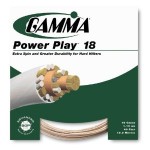
In string terminology, the word gauge refers to the thickness of the string in your racquet. The lower the number, the thicker the string.
The thickest string is 15 gauge. You will find this in most beginner racquets. Because it is thick, it is difficult to break. The frames in most beginner racquets, in fact, will usually break or bend before the strings break simply because the string is so thick.
The most common string in tennis is 16 gauge. This is what you will find in most tennis racquets. It is the preferred string for most recreational and competitive players. 16L gauge is a slightly thinner version of the popular 16 gauge string that dominates the string market today.
17 and 18 gauge stings, meanwhile, along with their thinner counterparts 17L and 18L, are used by advanced and professional players who want to create more spin.
Thin, high gauge strings are more elastic than thick, low gauge strings. This means that high gauge stings remain in contact with the ball longer on each stroke. As a result, they provide players with the potential for more power, more touch and increased spin. However, they also cost more and break easier than low gauge strings.
16 gauge string is the most popular string in tennis because it offers a middle ground between the durability of 15 gauge and the playability of 17 gauge strings.